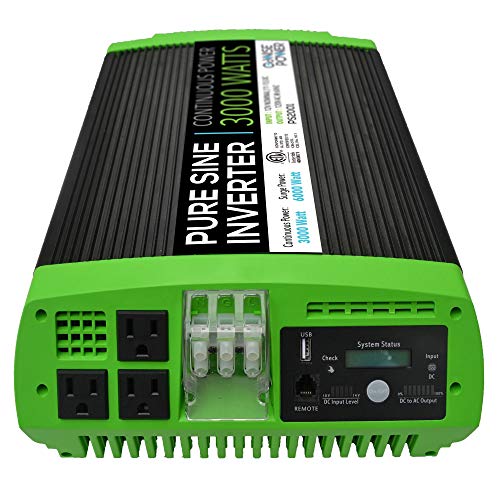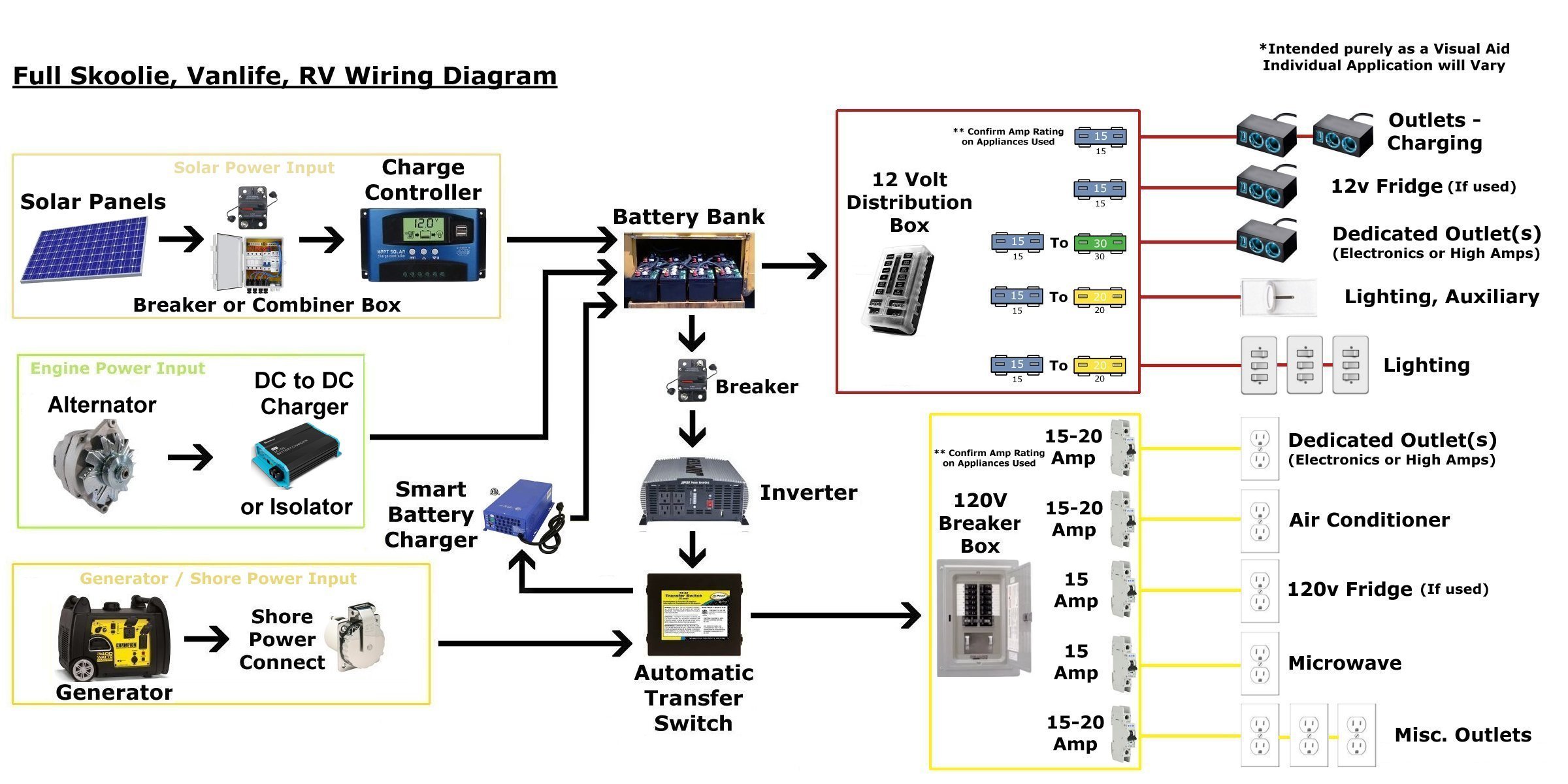There are valid reasons both for and against using a single item to accomplish these three tasks. Some prefer the flexibility of three separate items, and some prefer the simplicity of a Combination Unit or “All-In-One”.
In this Tutorial we will look into what factors you should consider in making this decision as well as show our top recommendations for each, but let’s start at the beginning.
If you wish to run 120v (household) electrical appliances in your Skoolie, Van, or RV, you have to either use an Inverter to convert that power from your Battery Bank (12, 24, or 48 volts) or draw 120v from an outside source or “Shore Power”.
For the newbies: Shore Power is typically an electrical service post in a campground, but can also refer to a simple extension cord plugged into an outlet in someone’s house or place of business, or even a Generator plugged into your Shore Power Connection. See the Solar 101 Tutorial for more information.
Shore Power can also be the most efficient to charge your Battery Bank. It isn’t absolutely required, but the use of a Smart Battery Charger will allow you to boost the level of your House Batteries via Shore when your Solar Panels can’t keep up with your power demands (several cloudy days in a row or times of heavy electrical usage or when you just want to speed up the charging process).
Switching from Inverter Power to Shore Power is normally accomplished by using an Automatic Transfer Switch, which, as the name implies, detects when Shore Power is connected and automatically disconnects the Inverter. - Once you unplug from Shore it reads the lack of an outside 120v power source and reconnects the Inverter to your 120v Breaker Box or “House Power”.
Historically, these three devices (an Inverter, Smart Charger, and Automatic Transfer Switch) have been used individually to accomplish their specific tasks, as noted above. - In recent years however, Combination Inverter/Charger/Switch “All-In-One” devices have become more and more popular and the technology has become more and more efficient and reliable.
Here are our top picks for each individual item, though the size you need may vary from that shown. Click the images to compare various sizes and similar items. - More options are available on the Solar Page, and thoughts on sizing it up (“how much solar”) can be found in our Solar Cheat Sheet.
Obviously, the biggest advantage to using an “All-In-One” is simplicity in use and connection. If you examine the following two images you will see that there will be less wiring required to use a Combination Inverter/Charger/Switch as well as less room for error in connecting it to the system.
Full Wiring Flow With 3 Separate Devices
Full Wiring Flow With “All-In-One” Inverter/Charger/Switch
So what would be the advantage to using three separate devices?
One consideration is the price. - The cost of a Combination Unit has come down quite a bit in the last few years and is now comparable to buying each item individually, though a well-educated shopper can certainly save money by going with three separate devices. - Here are a couple of our favorite Combination Units (3000w and 2000w, respectively). Click the images and compare the price to the individual cost of the three separate devices above.
What About Reliability?
While reliability of the All-In-One Units doesn’t seem to be a huge concern, you should consider that if your Combination Device does break down you are left with no source of 120v electricity.
Your 12v system should still work, as it is connected directly to the Batteries, but with no Inverter or Shore Power Connection (since there is no way to Switch to Shore) you will be totally reliant on 12v Power and have only the sun and engine charging (if equipped) to recharge the Batteries once depleted.
There are some simple work-arounds to this: You can run a drop cord into the rig to power 120v appliances one at a time. You can wire a Shore Power Connection directly to your Breaker Box and bypass the Inverter System altogether. You can even fire up the Generator and run directly from that. Just bear in mind that you will be doing this until you have the time and money to replace the All-In-One unit.
With three separate devices you would likely only have to replace one of them at any given time, at a much lower cost.
The main advantage to running a separate Inverter, Charger, and Automatic Transfer Switch, especially at first, is the added flexibility in upgrading or changing each individual item. The following are common issues that may arise requiring a re-sizing or scaling-up of specific components.
· Power Output: You may find that you use more power than your Inverter can supply. This is especially likely if you regularly use a microwave, hair dryer, or attempt to run air conditioning on solar. – Simply put, you never know for sure how much juice you’ll need until you get out on The Road. If you go with a 2000 watt All-In-One you might have to spend $700 - $1000 to upgrade the entire Combination Unit, vs. $400 or so if you only have to upgrade from a 2000w to a 3000 watt Inverter.
· Charging Capacity: Read the specs on your “All-In-One” before you buy, and have a look at the charging section of the Solar Cheat Sheet Tutorial. Most Combination Units have adjustable charging output, but some max out as low as 40 amps. This will certainly get the job done, and is more than enough for an average Battery Bank, but if you’re running a fairly large Lithium setup it will likely be slower than you desire.
· Power Drain: Those of you running 120v refrigerators, or other appliances that require you to leave your Inverter on at all times, may be unhappy with the “resting draw”. - An Inverter continues to use electricity as long as it is powered on. Even when no 120v appliances are running, it will continue to draw down your Battery Bank. The amount it uses is directly commensurate with the size of the Inverter. (The larger the Inverter the greater the Resting Draw.) This is why you hear of people using a smaller Inverter dedicated to their 120v fridge and shutting off the “main” Inverter when not in use.
So, which is it?
We usually recommend three separate devices, especially for those doing their first Build. - In addition to the considerations above, there is an advantage to the visual representation of what each unit does. “The Charger charges. The Switch switches, and the Inverter… ‘inverts’ ”. We just sort of prefer each device having “one job” vs. one unit with more things that can break.
If you prefer to see each item and understand it’s role in the overall setup, or feel that you will likely be upgrading or replacing things as you go, stick with a separate Inverter, Smart Charger, and Automatic Transfer Switch.
That being said, if you’ve done your research and feel that you have a good grip on what you need for power and charging capacity, you aren’t the type to be constantly upgrading to the latest and greatest gadgets, or if you just want the simplest solution to a complex system, the Combination Inverter/Charger/Transfer Switch is probably for you. - It’s also a good choice if you have very limited space or are putting your system together in stages, as shown in the Step by Step Solar Tutorial.
More product options are available on the Solar Page, and please read through our Solar 101, Solar Cheat Sheet, and Step-By-Step Solar Tutorials for a better understanding of how it all goes together.
Let’s Power Up and Get Rollin’!
Quick Links:
Start The Engine - Establishing a Budget - Making a Living on The Road - Choosing a Rig - Do I Need A CDL? - Designing a Skoolie Build - Step By Step Build Order - Skoolie Toolbox - Doing a Build On The Cheap - 10 Tips to Save Power and Money - Skoolie Build Ideas - Solar 101 - “Inverter/Charger/Switch” or 3 Separate Devices - Simple Solar - Solar Cheat Sheet - Step by Step Solar - Water Setup - Propane Setup - Skoolie, Van, & RV Air Conditioning DE_Mystified! - Skoolie Heating - Insulation - Digital Nomad Connectivity - Choosing a Domicile State - Converting a Commercial Title - Van, Skoolie, and RV Insurance - Camping Clubs, Subscriptions, and Passes - Road-Skool / Home-School - The Simple Skoolie Kitchen
Jump To Page:
Home - Tutorials - Solar - Cooking - Refrigeration - Water - HVAC - Tech - RV Accessories - Gear - Swag.








